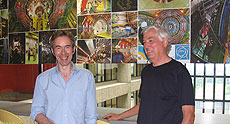New leadership for the LHC Physics Center

Beginning August 1, Ian Shipsey of Purdue University (left) will join Dan Green in directing the LHC Physics Center.
On August 1, the LHC Physics Center will welcome a new member to its leadership team. Ian Shipsey, a professor of physics at Purdue University, was appointed co-coordinator of the LPC in June 2009. He succeeds Chris Tully of Princeton, who now takes up the task of CMS Hadron Calorimeter Institution Board Chair.
Shipsey will join Fermilab's Dan Green in directing the Fermilab-based center, which works with the US CMS Remote Operations Center, accesses the US CMS Tier-1 Fermilab Computing Center and serves as a resource and physics analysis hub for the more than 800 U.S. physicists in the CMS collaboration.
Green said Shipsey will bring invaluable skills to the post.
"Ian is very outgoing, and he's good at outreach," Green said. "He will be a great liaison to the university community and will provide valuable managerial experience to the LPC."
Shipsey has an extensive leadership background, serving from 2001 to 2004 as co-spokesperson for the CLEO experiment, a general-purpose particle detector at the Cornell Electron Storage Ring. He helped to design the silicon detector for that experiment, and in 2001, he began working on the silicon detector for CMS. In 2007, he became the chair of the LPC Advisory Board, where he focused on strengthening the involvement of graduate students and postdocs in the experiment.
"There are 3,000 people working on CMS worldwide," Shipsey explained. "We want to bring them all to the table. There's such complex food on this table that it will take all 3,000 people, fully engaged, to figure out how to eat it."
For the next year, Shipsey will split his time between Purdue and Fermilab. He said he is thrilled to dive into the new work.
"The LHC is an unprecedented project," Shipsey said. "There has never been a machine like this; there has never been a challenge this complex. It's a bit like in the old days when people gathered to build a cathedral, to create something that transcends the people working on it. To be a part of this human story, as it's being written, is incredibly exciting."
-- Rachel Carr
|